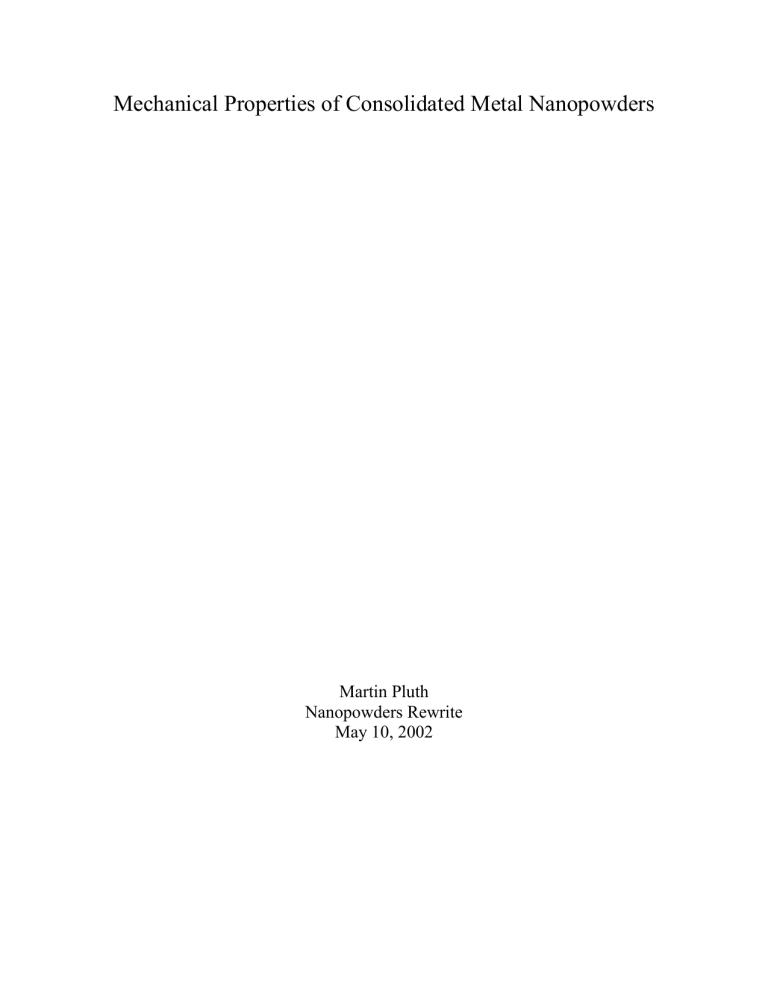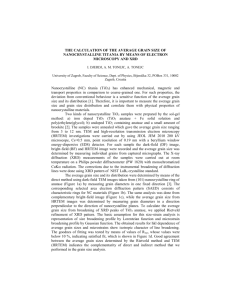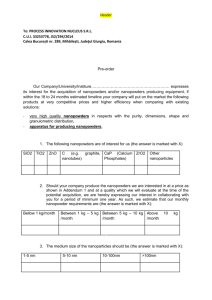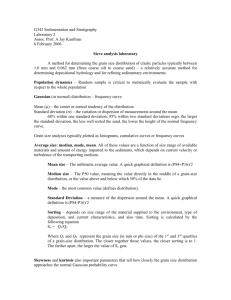Mechanical Properties, Marty Pluth

Mechanical Properties of Consolidated Metal Nanopowders
Martin Pluth
Nanopowders Rewrite
May 10, 2002
Introduction
Nanopowders have been under extreme investigation in the recent years due to their novel physical, chemical and mechanical properties. They have been studied for use as catalysts, fuel cells, pigments, gas absorbers, and a host of other applications. Their uniqueness arises from their high ratio of surface area to volume, as these materials have diameters of 100 nm or less.
It has been well established that these ‘far from equilibrium’ materials exhibit strange mechanical properties. One is much higher yield and tensile ultimate strength. Strength increases on the order of 15 times that of bulk material have been achieved. Hardness values and compressive yield strengths have also seen great leaps. However, there may be a remarkable drop in tensile modulus and elongation as one reduces the particle size below a diameter of ~100 nm. This drop has led to many theories about the nature of consolidated nanopowders, including similarities to metallic glasses and amorphous-crystalline behavior.
The Hall-Petch relationship is used to predict the grain size-yield strength relationship in polycrystalline metals. This relationship is limited to relatively strain-free materials and predicts
that yield point will increase linearly with the inverse square root of the grain size.
y
=
o
+ k y d -½
This equation has been verified for large-grained materials (d > 100 nm) [1,2], in which
(1) dislocations can glide through grains and pile up at grain boundaries. As stress builds up in one grain, adjacent strain-free grains will flow to reduce the stored energy. The stress gradient between the grains directly correlates to lower stress for flow. Therefore, by minimizing the amount of stress concentration in a grain, one could maximize the stress required for flow. One way of achieving this is to minimize the number of dislocations that can be present in the grain by reducing the grain size. This will limit the dislocation density of the grains, and result in higher stresses for plastic flow.
Nanopowders
Processing
Nanosized metals have been produced through a variety of methods, including severe plastic deformation (mechanical alloying, high energy ball milling, equal channel angular pressing), inert gas condensation, layer deposition, and chemical precipitation. Inert gas condensation is a particularly important method in the generation of nanopowders. Metal atoms in the vapor phase collide with inert gas molecules and lose kinetic energy. As they lose energy, they transform from the vapor phase to the solid phase as small nanoclusters. These clusters are then collected on a cold finger, which is scraped to produce the nanoscale powders.
Metal atoms are introduced into the system as a vapor by many potential methods. Bulk pure metals can be resistively heated in ceramic crucibles at high heating rates to transform the metal from solid to gas. Alternatively, the gas molecules can be created by the energy from a plasma plume (such as in pulsed laser ablation), or electric arc (such as in the exploding wire or plasma arc melting). Generally, high purity helium is used as the inert gas to promote crystallization, and collection is achieved with a liquid nitrogen cooled stainless steel cold finger. Once the powders have been scraped off, they fall into a die for compaction into usable bulk samples.
These samples are generally small, ~ 2-4 mm in thickness and 8-80 mm in diameter. The powders are compacted either at room temperature, or elevated temperatures to promote compaction. Studies have indicated that warm pressing the powders results in an improvement in density, from ~95% to ~98% density, in the copper and palladium metal systems. [3] Purity of the gas stream is also of great importance to achieve highly dense consolidated nanopowder compacts. Improvements in some reactors have led to density increases from ~90% to ~95%.
Powders that were compacted after having been exposed to air demonstrated much lower densities than conventional inert gas condensed material. [4]
It has been found that other gasses can be fed into the system (including oxygen) to cause reactions with the highly active nanopowders. This causes a thin scale of oxide (or nitride, etc.) to form on the surface of the nanopowders. This scale can cause as many problems as benefits, and so is rarely used. One metal that is investigated in this fashion is 53 nm diameter passivated aluminum. [5] By allowing trace presence of oxygen in the system, Al
2
O
3 is allowed to form as a
0.5 to 4 nm scale on the spherical (or faceted) nanopowders. This scale, once compacted, results in the material having a continuous network of alumina at the grain boundaries. This has many effects, including inhibiting grain growth (promoting thermal stability), and acting as a binder to the material.
Characterization
Physical properties of consolidated nanopowders are determined in a variety of ways. To determine the density of these bodies, Archimedes principle is employed. The sample of known dimension and mass is submerged in a fluid and the resulting displacement is measured. The deviation of this fluid from the theoretical density of the material (calculated from the mass and volume of the sample) shows the degree of porosity. Alternatively, positrons are sent through the sample and the time to decay and/or the signal loss through the material can be measured and correlated to density. [4] Small Angle Neutron Scattering (SANS) can be utilized to determine density if the mean pore size and the nature of potential scattering events are reasonably well understood before testing. This method cannot solely be relied upon, however, because pores can exist which are too large for SANS to resolve effectively. [6]
To determine the nanocrystalline grain size, techniques such as gas adsorption, TEM observation and x-ray peak broadening can be employed. Each of these methods will give a different clue to the powder diameter, whether by measuring area, volume or diameter. Because so many of the mechanical properties are based upon particle size, the distribution inherent to the processing method is generally of great importance. Self-sharpening particle distributions are desired to maximize the nanoscale yield of a process and minimize internal forces present in the consolidated material. The inert gas condensation method is not known for an extremely narrow particle distribution, but it can be tailored to produce consistent results.
Difficulties
Consolidated nanopowders pose many problems for accurate testing. One of the most significant problems is porosity. Current process limitations result in densities on the order of ~98% theoretical. However, this was not always the case. Maximum density in the late 1980s and early
1990s topped out at ~90%. Studies of elastic modulus during this time span showed a extreme deviation from expected, and yield strengths displayed either non-linear or sometimes an inverse
Hall-Petch effect below 100 nm [1, 2]. Under testing, nanomaterials appeared to grow less strong as grain size decreased below 100 nm; yield stress decreased linearly with decreasing grain size.
This led to the development of many erroneous models to predict and describe what was happening in the grain. One of the most prominent was the belief that the nanosized grains were separated by an amorphous or extremely low short-range ordered grain boundary. The presence of high volumes of these less-dense grain boundaries was to be blamed for the difference between calculated and measured density. This model predicted higher solubility for immiscible systems based upon the ideas that the solute atoms could exist in the nether regions between grains and that the low-density grain boundaries would stretch the lattice of the grains, allowing for solid solution. Improvements in processing techniques quickly disproved these beliefs as density increases led to near-Hall-Petch behavior [7], but many other fallacies may exist.
Agglomeration is a definite problem in consolidated nanopowders. These entities are extremely small in nature, and thus are under greater influence by relatively small forces. One of the most apparent is Van der Waals forces. These forces are caused by a temporal charge distribution in each individual nanopowder, and can cause rapid agglomeration into branched bodies. These bodies are difficult to break up on compaction and sintering, and thus lead to inter-agglomerate voids and residual porosity in the sample. [8]
A secondary difficulty arising from Van der Waals forces is grain coalescence. When two nanopowders come into contact, there is an extreme negative radius of curvature at their interface. The driving force for the reduction of this curvature is immense, and it causes material to transport from the interior of the grain to the neck region. This makes the particle larger, destroys the spherical shape, and results in broad distributions of particle size. Additionally, once enough of the powders coalesce, there will be a driving force for the reduction of the small particles through Ostwald ripening. There is activation energy for both this reaction and the coalescence, which is generally temperature independent. However, there is an Arrhenius rate of reaction associated with each process that is temperature dependant. While not terribly rapid, this phenomenon can be observed in time spans as short as a couple of days at room temperature.
Elevated temperatures greatly exacerbate the issue. For this reason, may powders generated experimentally must be kept in a chilled, dry environment to prevent grain growth.
As with any other scientific experiment, repeatability during testing is an important issue. One must be able to verify another’s results. This can be particularly taxing in consolidated nanopowders. Particle distributions, sample testing conditions, ambient humidity, and many other factors can change the results of a mechanical test. It is for this reason that much of the reported mechanical property data available today is taken more or less on faith, and why glaring fallacies can be taken as gospel for an extended period of time.
Conversely, there are a few systems that show reasonable repeatability, and therefore these systems have been studied almost at the exclusion of any other in terms of inert gas condensed materials. Two prominent materials are copper and palladium metals. Significant research has been performed on these two materials at Northwestern University and at Argonne National Lab
[3, 6, 7]. Other experiments have been undertaken in China [4]. Additional materials under investigation include aluminum and its alloys [5], iron powders, and tantalum [8]. The lack of processing knowledge and ability prevents consolidated nanopowders from being all they are
capable of. With further investigations into the techniques, a greater range of this material will be available, with a commensurate drop in price and increase in availabilities.
Because these powders are difficult to create in large scales, sample geometry must be taken into account and testing parameters modified. Much of the early testing was performed on disks of material. This led to reliance on hardness and bend tests, which were easily correlated with geometry. However, the minimum required information on a material is generally achieved from a stress-strain test. This gives an insight into modulus, stress-strain profile and strain to failure, fracture morphology, and a host of other important parameters. Standardized testing has been modified in scale for these parameters. However, small samples often cause less than ideal testing coupons. This can include too short of gage length, inadequate thickness and insufficient polishing leading to crack initiation and/or introduction of stresses from preparation. [3] In addition, whereas strain can be measured simply from gage displacement in larger samples, the totality of deformation must be used for all calculations on small entities. This means that the grip area must be evaluated along with the gage. Non-gage geometry can cause difficulties in calculating stress and area, especially in the fillet regions, and this has caused inaccurate reporting of tensile modulus up until recent years. On materials with extremely small grain sizes, it has been calculated that a critical flaw size of 100 nm would be needed to initiate brittle failure in a testing coupon. [9] This extremely small scale for minimum crack size arises from the absence of dislocations in the material. Dislocations help to blunt crack tips and reduce the stress concentration ahead of the propagating crack. [6] By minimizing the grain size one has minimized the dislocation density, and created a ready means for catastrophic failure. This is an extremely small window for error, and thus data from these tests can be difficult to interpret. The biggest error this causes is inaccurate strain-to-failure, leading to incorrect modulus values.
[3]
Mechanical Properties
Tension/Compression
Most of the work on nanomaterials in tension and compression has been performed by P.G.
Sanders and J.R. Weertman at Northwestern University. [3] On nanocrystalline copper they found tension strengths in excess of 1.5 times the bulk, coarse-grained material. The deviation from Hall-Petch was explained for yield strength by the variability in strain to failure and the resulting miscalculation of modulus. These studies were performed on material with an average grain size ranging from 100 to 10 nm. Most of the results indicated an increase in yield strength from 1.2 to 1.45 times that of coarse-grained material. The increases in ultimate strength were more pronounced, with increases on the order of 1.45 to 1.65. Density in all these cases was
Table 1: Tensile Properties of NC Cu and Pd. [3]
Figure 1: Stress-Strain plots for Cu using strain gauges (one symbol for every 100 data points). [3] greater than 98.5%. However, the total elongation was measured to be much smaller than the 8% attributed to bulk copper. These studies found elongations ranging from 1.6 to 2.4%. Again, this low ductility was attributed to the presence of catastrophic failure originating from microcracks.
Tensile data can be seen in Table 1, and a plot of stress-strain can be seen in Figure 1.
Inert gas condensed palladium was also studied in tension by Sanders and Weertman. They found that for samples ranging from 30 to 50 nm there was an increase of 2.2 to 2.6 times in the yield strength and an increase of 1.85 to 2.15 times in ultimate strength. When the density of the samples is taken into account (no samples were greater than 98.6% dense), it appears the strengthening effect of nanocrystallinity on palladium is extremely potent! These samples also exhibited the low ductility of the copper samples. In this case, ductility measured from 2.6 to 4%, as compared to 8% for bulk palladium.
The effect of porosity on tensile modulus has been determined empirically by the function:
E = E o e
( P)
(2)
In this equation, E o is the modulus of a 100% dense material, P is the porosity and
a constant
Figure 2: Young’s Modulus as a function of porosity for nanocrystalline Cu and Pd. [3]
based upon material constants (generally in the range of 3 - 4.5). [3] For the copper and palladium nanopowders this equation was verified using
= 2.4 or 4, depending on processing parameters. The extrapolated modulus for palladium was very close to the bulk value (130 GPa as compared to 133 GPa), but the copper was slightly off (121 GPa compared to 128 GPa).
However, there is debate on the actual modulus of copper because of its extreme anisotropy.
Literature values have been reported in the range of 110 to 130 GPa. This indicates a much better fit for the condensed copper nanopowders. A plot of Young’s modulus vs. density can be seen in
Figure 2. Other factors resulting in the reduction of elastic modulus for nanopowders include soft grain boundaries, pores, dislocations and grains in a preferred orientation for flow. [10]
Aluminum nanopowders have been tested in the sintered and cold-deformed condition. [5] This work found strengths on the order of 12.5 times that of bulk material for tensile yield strengths.
All materials in the study were of density between 96 and 98% of theoretical. Higher densities should lead to even higher mechanical properties. Material that had been cold deformed before annealing showed much higher density (approximately 99%) but failed to show any appreciable increase in yield strength as compared to non-deformed. However, the strengths were still on the order of 2 to 3 times that of similarly cold deformed material. In the materials with higher than
96.5% density, it appeared that the tensile specimens failed from ductile means. The crack was at
45° angle to the loading direction, and the crack face exhibited a characteristic cup and cone fracture. Samples below this failed in a brittle manner, with the crack perpendicular to the load direction and a characteristically brittle crack face. Typical
-
curves are seen in Figure 3.
Tantalum nanopowders have been studied under high strain rates for use in military applications.
[8] These materials were consolidated in a slightly different (but similar) manner. These materials were tested at strain rates ranging from 1000/s to 12000/s, and performed much better than the coarse grained material. Maximum true stress increased from ~1000 MPa in the coarse materials to as high as 2500 MPa in the nanomaterials. Two lots tested under the same strain rates varied by a factor of 2.2 between bulk and nano. Most dramatic, however, was the change
(a) (b)
Figure 3: Stress-strain curves of NC Al sintered at 635 °C and annealed coarse grain Al (a) and stress-strain curves of cold deformed NC Al and two other coarse grained Al (b). [5]
(a)
(b)
Figure 4: True Stress-true strain curves from consolidated coarse (a) and nanocrystalline (b) tantalum. [8] in true strain to failure. Most of the bulk materials failed between 0.12 and 0.18 true strain.
However, the nanopowders failed from 0.15 to as high as 0.7 in the higher strain-rate material.
Figure 4 illustrates the true-stress true-strain behavior of this material.
Because of the inherent nature of crack opening leading to brittle failure in consolidated nanopowders, compression tests have been utilized in an effort to obtain a more accurate value for elongation. [6] While this method is not free from its own problems (such as barreling), the results appear to correlate much better than the tension tests. Additionally, it is apparent that the materials may have a much higher degree of strengthening than previously believed. In nanocrystalline copper and palladium (yield strength of ~50 MPa), compression values for yield
Figure 5: Compressive Stress-Strain curves for nanocrystalline Pd (a) and Cu (b). Strain Rate = 10 -3 /s. [6] strength have been astounding (0.6 to 1.15 GPa!). [9] Potential variations from know bulk material parameters such as modulus and elongation most likely arises from porosity and erroneous strain measurement. As seen in Figure 5, sample Cu1 of nanocrystalline copper has extremely low strain to failure, and this specimen had only 92% density. [6]
Microhardness
There has been much work on establishing Vickers microhardness values for nanomaterials.
Because hardness does not so greatly depend upon sample geometry, this test is suitable for small disks of material. However, this testing procedure is still greatly influenced by porosity, and improvements in that regard have led to phenomenal changes in reported hardness. [6] This test is also important because it can be well correlated to the yield strength of the material. For materials which do not significantly work harden, the yield strength (in MPa) can be approximated as 1/3 the Vickers hardness times a proportionality constant. In tests on nanocrystalline copper and palladium, the H v
/3 value has well correlated with the Hall-Petch relationship and does a good job describing the tensile properties where sample size could be a problem for tensile testing. One such example is a study by Sanders which reported excellent correlation on samples with greater than 95% density. [6] In it they found differences between compressive yield strength and H v
/3 on the order of 2-5% for grain size less than 50 nm. These values were approximately 3 times greater and 4 times greater than bulk copper and palladium, respectively.
Fatigue
Tension-tension fatigue tests have been carried out on nanocrystalline copper. [11] The samples appeared to have extremely good fatigue properties even at large fractions of the estimated yield stress. The tests induced a permanent amount of strain to the material, accommodated in the form if shear bands on the surface of the testing coupon. Additionally, the material tested exhibited as
light propensity for grain growth due to stress loads. By varying the stress load on the samples it was concluded that deformation was primarily elastic during the fatigue test.
There did arise a problem with this test, however, revolving around the value of the material properties. For the stress and strain values to be correct, the modulus of the material appears to be different from expected by about a factor of 3. This is most likely an effect of porosity, but further investigation into the matter is warranted. The presence of shear bands is not uncommon in materials such as metallic glasses, and it is believed that consolidated nanopowders may behave in a similar way.
Discussion
It seems that the ability to create both consistent and large volumes of nanopowders will be a great asset to future applications. The high mechanical properties observed will allow for stronger (or lighter) structures, and therefore this technology would be of great interest to the aerospace industry. Strength values as high as 15 times will allow a much greater factor of safety for current parts, or allow these structures to enter operating parameters not yet able to be realized.
While copper and palladium are not of significant structural use, the knowledge gained from them will be pivotal in the study of other, more structurally relevant, materials. Assuming that the process can be adapted for large-scale production and other materials can be created in this fashion, it seems there may be a materials explosion in the next two decades. Two material systems that would greatly benefit from this would be the titanium and aluminum alloys. In all cases it is extremely apparent that porosity may play a greater role in determining mechanical properties than grain size itself. Being able to produce a consistent 100% dense consolidated structure may be the key to the wide scale application of these materials. However, it has been seen that the presence of pores and oxide inclusions helps to prevent grain growth.
Unfortunately, it appears that once fully dense samples are realized, a host of other problems will arise due to thermal instability of the powders. Grain size will be extremely difficult to maintain.
The work being performed on aluminum bodes very well for this technology. The presence of the thin alumina scale helps to prevent grain growth in these samples. Thus, typical powder metallurgy practices of consolidation and sintering could be applied. This would greatly enhance their viability. It has been shown that the oxide scale also allows for the materials to be taken to
1000 °C, well above the melting point of 660°C, and remain intact. This may seem trivial at first, but most importantly it allows for the process of heat-treating in the form of precipitation hardening. Most of the structural aluminum alloys are strengthened through this process. If alloys can be repeatably produced in nanopowder form, there will be immediate usage for the Al-
Cu-Mg and Al-Zn-Mg-Cu systems. Binary Al-Cu and Al-Zn alloys are being studied by V.K.
Vasudevan and associates at the University of Cincinnati.
For all the difficulties associated with the production and testing of nanopowders, this author feels that it is of paramount importance to understand this class of materials. Not only may they be of great use for structural applications, they allow insights into a world that is only marginally understood. As particle size decreases, some of the theories that scientists hold dear begin to break down. This means that new insights into the role of dislocations, grain boundaries, and
particle size on mechanical properties can be obtained. Likewise, old thermodynamic principles can be reviewed and possibly modified, or new ones introduced. These materials allow for a great amount of scientific study and should be thoroughly investigated.
References
[1] Chokshi, A.H., Rosen, A., Karch, J., Gleiter, H., Scripta Met . 23 (1989) pp.1679
[2] Nieman, G.W., Weertman, J.R., Siegel, R.W., Scripta Met.
23 (1989) pp. 2013
[3] Sanders, P.G., Eastman, J.A. and Weertman, J.R., Acta mater . 45 , No. 10 (1997) pp. 4019-4025
[4] Wu, X.J., et al., NanoStructured Materials 12 (1999) pp. 221-224
[5] Sun, X.K., Cong, H.T., Sun, M., Yang, M.C., Met. Trans. 31A (2000) pp. 1017-1024
[6] Sanders, P.G., Youngdahl, C.J., Weertman, J.R., Mat. Sci. and Engineering A234-234 (1997) pp.77-82
[7] Sanders, P.G., Fougere, G.E., et. al., NanoStructured Materials 8 (1997) pp 243-252
[8] Yoo, S.H, Sudarshan, T.S, Sethuram, K., et al., NanoStructured Materials 12 (1999) pp. 23-28
[9] Youngdahl, C.J., Sanders, P.G., Eastman, J.A., Weertman, J.A., Scripta Mat. 37 No. 6 (1997) pp. 809-813
[10] Okuda, S., Journal of Alloys and Compounds 310 (2000) pp. 124-126
[11] Whitney, A.B., Sanders, P.G., Weertman, J.R., Eastman, J.A., Scripta Met. et. Mat . 33 No. 12 (1995) pp. 2025-
2030








